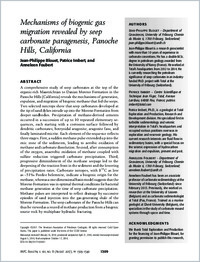Mechanisms of biogenic gas migration revealed by seep carbonate paragenesis, Panoche Hills, California
- Blouet, Jean-Philippe Department of Geosciences, University of Fribourg, Switzerland
- Imbert, Patrice Centre Scientifique et Technique Jean Féger, Total, Pau, France
- Foubert, Anneleen Department of Geosciences, University of Fribourg, Switzerland
-
2017
Published in:
- AAPG Bulletin. - 2017, vol. 101, no. 8, p. 1309–1340
English
A comprehensive study of seep carbonates at the top of the organic-rich Maastrichtian to Danian Moreno Formation in the Panoche Hills (California) reveals the mechanisms of generation, expulsion, and migration of biogenic methane that fed the seeps. Two selected outcrops show that seep carbonates developed at the tip of sand dykes intrude up into the Moreno Formation from deeper sandbodies. Precipitation of methane-derived cements occurred in a succession of up to 10 repeated elementary sequences, each starting with a corrosion surface followed by dendritic carbonates, botryoidal aragonite, aragonite fans, and finally laminated micrite. Each element of the sequence reflects three stages. First, a sudden methane pulse extended up into the oxic zone of the sediments, leading to aerobic oxidation of methane and carbonate dissolution. Second, after consumption of the oxygen, anaerobic oxidation of methane coupled with sulfate reduction triggered carbonate precipitation. Third, progressive diminishment of the methane seepage led to the deepening of the reaction front in the sediment and the lowering of precipitation rates. Carbonate isotopes, with δ¹³C as low as −51‰ Peedee belemnite, indicate a biogenic origin for the methane, whereas a one-dimensional basin model suggests that the Moreno Formation was in optimal thermal conditions for bacterial methane generation at the time of seep carbonate precipitation. Methane pulses are interpreted to reflect drainage by successive episodes of sand injection into the gas-generating shale of the Moreno Formation. The seep carbonates of the Panoche Hills can thus be viewed as a record of methane production from a biogenic source rock by multiphase hydraulic fracturing.
- Faculty
- Faculté des sciences et de médecine
- Department
- Département de Géosciences
- Language
-
- English
- Classification
- Geology
- License
-
License undefined
- Identifiers
-
- RERO DOC 305064
- DOI 10.1306/10171616021
- Persistent URL
- https://folia.unifr.ch/unifr/documents/306181
Statistics
Document views: 91
File downloads:
- pdf: 148
